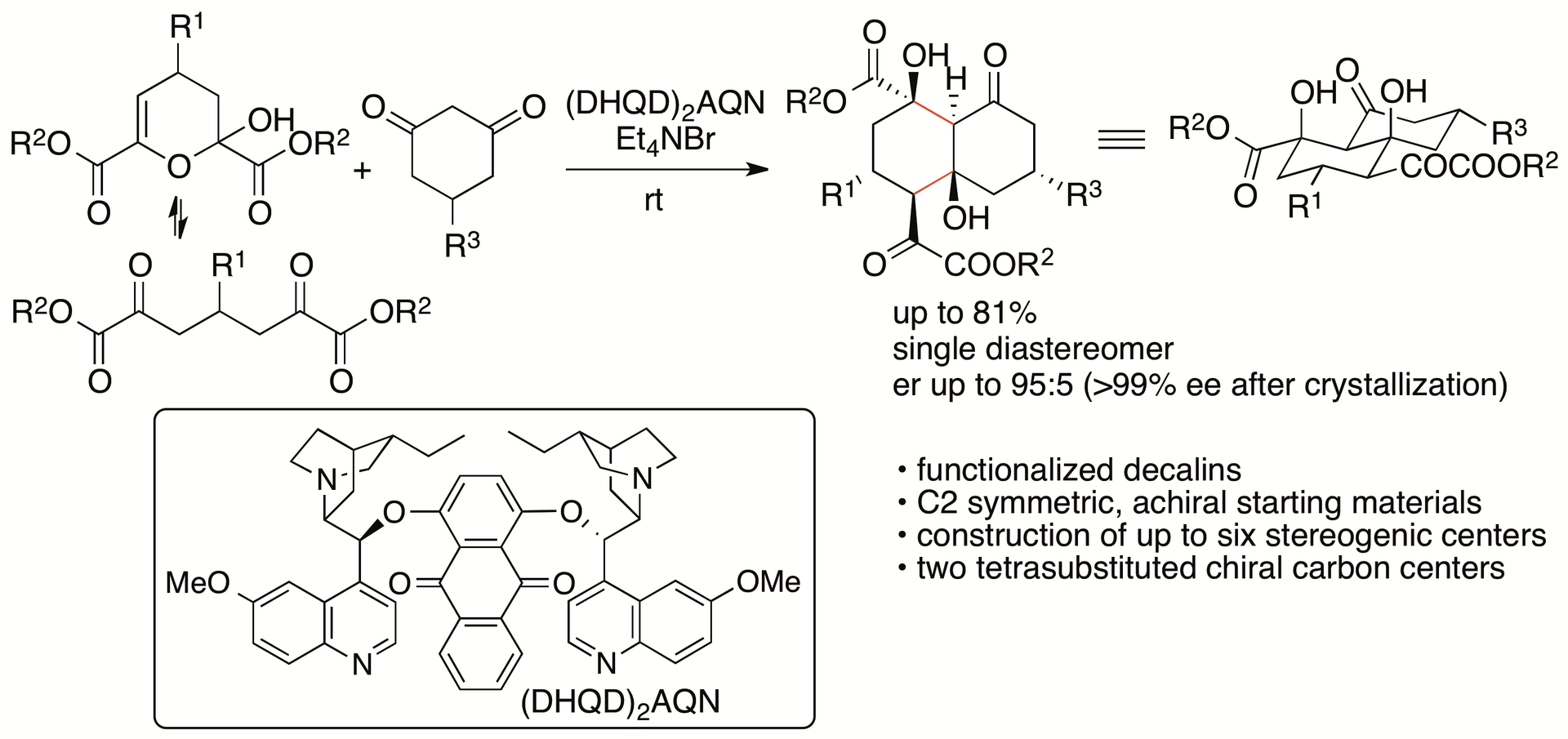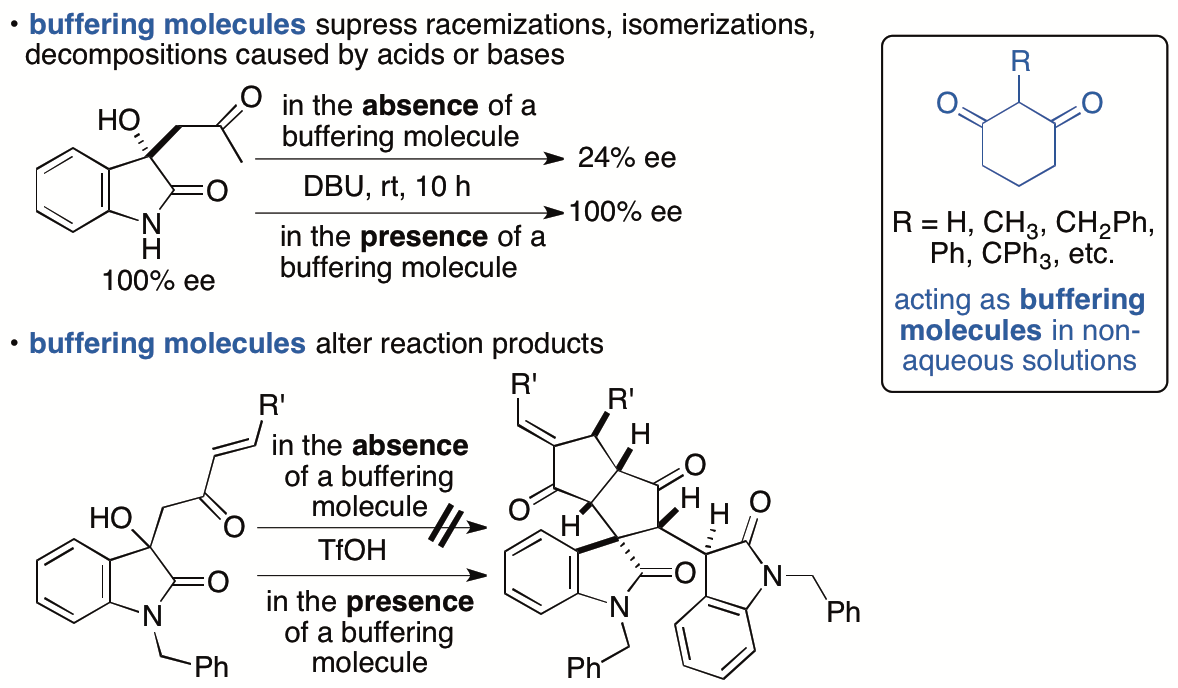FY2021 Annual Report
Chemistry and Chemical Bioengineering Unit
Professor Dr. Fujie Tanaka, Professor
Abstract
The ability to design and synthesize organic molecules constitutes the foundation that underlies basic research as well as applied science. The ability is also essential for the development of pharmaceuticals and biofunctional molecules. This unit develops efficient, concise, and safe chemical transformation methods and strategies for constructing small molecules bearing functional groups and/or chiral centers that are relevant to the creation of biofunctional molecules. We design and create small organic molecule catalyst systems for designed chemical transformations, and we develop reaction strategies that use small organic molecules as enzyme-like catalysts. With the use of organic molecules as catalysts, we minimize the need for protection and deprotection steps that are usually required for the synthesis of functionalized molecules. When a reaction method does not affect functional groups that are not at the reaction site, the reaction method can be used for the synthesis of a series of molecules bearing various functional groups. This means that a series of molecules of interest may be synthesized using the same method in a short route, providing advantages for the synthesis of biofunctional candidate molecules. We also investigate the chemical bases of the reactions to understand the mechanisms of the catalysis and molecular interactions provided by organic molecules. By taking advantage of the use of features of our developing molecules, we also develop strategies and methods for conjugation of proteins and peptides with other molecules. The research undertaken by this unit advances the chemistry of catalysis and of molecular synthesis. The studies by this unit accelerate the creation of molecules used in biomedical research and contribute to the development of new therapeutics, therapeutic strategies, and diagnostic methods.
1. Staff
- Dr. Ravindra D. Aher
- Dr. Venkati Bethi
- Dr. Santosh Chavan
- Dr. Yuvraj Garg
- Dr. Yarkali Krishna
- Dr. Maulik Mungalpara
- Dr. Prodip M. Roy
- Dr. Muhammad Sohail
- Kola Shilpa
- Santanu Mondal, Graduate Student
- James Osborne, Graduate Student
- Kuan-Lin Chen, Graduate Student
- Maira Pasha, Special Research Student
- Yu-Ju Lin, Graduate Student (Rotation)
- Maho Kihara, Intern Student
- Shiho Chinen, Research Unit Administrator
2. Activities and Findings
2.1. Development of new chemical transformation methods and synthesis of functionalized molecules
We have been developing small organic molecule catalysts (organocatalysts) and organocatalytic molecular transformation methods useful for the synthesis of functionalized molecules under mild conditions in short routes. We also investigate the chemical bases of the catalyses and the chemical transformations to understand the mechanisms of the catalysis and molecular interactions provided by organic molecules to further the creation of useful molecules.
Traditional synthetic methods often require high or very low temperatures and/or absolute conditions. In addition, functional groups on substrate molecules must be protected prior to reactions. That is, depending on functional groups present in target molecules to be synthesized, synthetic routes, including protection and deprotection steps, have to be designed for each molecule. To concisely synthesize functionalized molecules, chemical transformation methods that are not affected by functional groups presenting in starting materials are needed. It is a great advantage when the same reaction method can be used for the synthesis of a series of molecules bearing various functional groups without the need of product-specific protection and deprotection steps. In addition, it is desired that such reactions can be performed under safe, mild, and environmentally benign conditions. We address these points in our research as we design and develop catalysts and chemical transformation methods. By using organic molecules as catalysts, we concisely synthesize novel functionalized molecules including those that are often difficult to synthesize by traditional synthetic strategies. Our investigations into the chemical basis of the developed catalysts and chemical transformation methods further the understanding of the chemistry of organic molecules and their reactions.
2.1.1. Direct enantioselective Mannich reactions of pyruvates catalyzed by amine-based catalyst systems: Control of reactions of pyruvates
Pyruvates or 2-oxopropanoates act as electrophiles and nucleophiles and are useful compounds for the synthesis of various molecules. In Nature, pyruvate is a precursor for amino acids, sugars, cofactors, and other biofunctional molecules. In enzyme-catalyzed reactions, pyruvates often serve as nucleophiles. In contrast, in the majority of non-enzymatic reactions of pyruvates, pyruvates serve as electrophiles due to the activated reactivity of the α-ketocarbonyl structure. Without the use of enzymes, the control of the nucleophilic reactivities of pyruvates, especially simple pyruvates such as ethyl pyruvate, is difficult. Reactions of pyruvates often results in the formation of self-aldol reaction products and cascade reaction products, in which pyruvates act as both nucleophiles and electrophiles. We have developed direct enantioselective Mannich reactions of pyruvates catalyzed by an amine-based catalyst system, in which pyruvates act as nucleophiles without acting as electrophiles (Schemes 1 and 2) (Mondal, Aher, Bethi, Lin, Taniguchi, Monde, and Tanaka, Org. Lett. 2022, 24, 1853).

Scheme 1

Scheme 2
The acidity and the structure of the acid used in the amine-based catalyst system influenced the yield and the enantioselectivity; the acid component of the amine-based catalyst system was key to obtain the desired Mannich products in high yields with high enantioselectivities. The acid in the amine-based catalyst system also affected the formation of the self-aldol products of pyruvates. The developed catalyst system catalyzed the desired Mannich reactions more favorably than the self-aldol reactions of pyruvates.
The products of the developed Mannich reactions of pyruvates have the α-ketoester group that is originated from the pyruvates. Using the α-ketoester group of the products as the reaction site, α,γ-diamino acid derivatives and γ-amino α-hydroxyacid derivatives were readily synthesized.
2.1.2. Construction of highly functionalized decalin derivatives: aldol-aldol annulation reactions
We have recently developed catalytic enantioselective formal (4+2) cycloaddition reactions of dihydropyran derivatives with cyclohexane-1,3-diones that afford functionalized decalins through aldol-aldol annulation (Scheme 3) (Chouthaiwale, Aher, and Tanaka, Angew. Chem. Int. Ed. 2018, 57, 13298). The decalin ring system is found in diterpenes, diterpenoids, steroids, and other bioactive molecules, and thus the development of methods for the synthesis of functionalized decalin derivatives is of interest in drug discovery and related research.

Scheme 3
Key factors of the success of the reactions include the use of the dihydropyran derivatives as the starting materials, which are obtained from pyruvates and aldehydes (Chouthaiwale and Tanaka, Chem. Commun. 2014, 50, 14881; Chouthaiwale, Lapointe, and Tanaka, Heterocycles 2017, 95, 587). The starting material dihydropyran derivatives retain the α-ketoester group of pyruvates and are C2 symmetric molecules, allowing direct enantioselective transformations to provide the products in high yields (in contrast to that kinetic resolutions result in yielding the products in no higher than 50%).
We are currently investigating the detail mechanisms of the reactions. We are also investigating essential parts of the catalyst structure for the catalysis and the stereocontrol.
2.1.3. Construction of spirooxindole polycyclic derivatives
Spirooxindole derivatives are found in bioactive natural products. Functionalized molecules with spirooxindole cores including those with polycyclic systems should be useful in drug discovery efforts. We have recently reported formal (4+1) cycloaddition and enantioselective Michael-Henry cascade reactions that provide spirooxindole polycycles via spiro[4,5]decane derivatives (Scheme 4) (Huang, Sohail, Taniguchi, Monde, and Tanaka, Angew. Chem. Int. Ed. 2017, 56, 5853). The reactions provided spirooxindole all-carbon polycyclic derivatives with seven stereogenic centers, including two all-carbon chiral quaternary centers and one tetrasubstituted chiral carbon center.

Scheme 4
Whereas kinetic resolution reactions afford the products up to 50% yield, dynamic kinetic transformations can lead to the formation of the products up to 100%. We have developed dynamic kinetic transformation-based diastereo- and enantioconvergent Michael-Henry reactions that afford spirooxindoles bearing furan-fused rings (Scheme 5) (Sohail and Tanaka, Angew. Chem. Int. Ed. 2021, 60, 21256). Dihydrobenzofuranone derivatives were synthesized in racemic diastereomer mixtures (Scheme 6), and these were transformed to the spirooxindoles bearing furan-fused polycycles with high diastereo- and enantioselectivities through the dynamic kinetic process (Scheme 7). Regardless the stereochemistry of the dihydrobenzofuranone derivative, all four isomers originated by central and axial chiralities were transformed to the single diastereomer product with high enantioselectivities.

Scheme 5

Scheme 6

Scheme 7
Usually, these complex, polycyclic molecules are synthesized by multi step routes. Our strategies allowed the access to the complex functionalized molecules including those as highly enantiomerically enriched forms in short routes.
We are also investigating to provide other spiro polycyclic products and to expand the capabilities for the synthesis of functionalized molecules with spiro ring and polycyclic ring systems.
2.1.4. Construction of tetrahydropyrans: oxa-Diels-Alder reactions
We previously reported catalytic asymmetric hetero-Diels-Alder reactions of enones with isatins (2,3-dioxyindoles or 2,3-dioxyindolins) that provide functionalized spirooxindole tetrahydropyranones with high diastereo- and enantioselectivities (Scheme 8) (Cui and Tanaka, Chem. Eur. J. 2013, 19, 6213). Novel amine-based catalyst systems composed of three-types of molecules (amine, acid, and thiourea) were developed to catalyze the reactions.

Scheme 8
We have been expanding the oxa-hetero-Diels-Alder reactions of enones beyond the use of the oxindole dienophiles to the use of various ketones and aldehydes as dienophiles. For example, we have developed diastereo- and enantioselective hetero-Diels-Alder reactions of enones with aryl trifluoromethyl ketones (Schemes 9 and 10) (Pasha and Tanaka, Org. Biomol. Chem, 2021, 19, 9242). With our newly developed catalyst systems, tetrahydropyranones were obtained with high diastereo- and enantioselectivities, and the major diastereomers of the products had the relative stereochemistry different from that of the reactions that we have previously developed (Zhang and Tanaka, RSC Adv. 2016, 6, 61454). That is, we have demonstrated that both diastereomers of the tetrahydropyranone products can be synthesized by altering the catalyst system. Because the reactions of enones with ketones often give only aldol products, our developed reactions that directly afford functionalized tetrahydropyranones are notable.

Scheme 9

Scheme 10
We are further studying and developing diastereo- and enantioselective hetero-Diels-Alder reactions and other strategies in order to allow the concise access to functionalized various tetrahydropyran derivatives with highly diastereo- and enantioselective manners.
2.1.5. Design and synthesis of catalysts
We have been developing new catalysts to accelerate enantioselective chemical transformations. For example, using the Mannich reactions that we recently developed (Scheme 11) (Yuvraj and Tanaka, Org. Lett. 2020, 22, 4542), we are designing and synthesizing amine-derived catalysts that have contiguous chiral centers. The addition of K2CO3 in the 3-pyrrolidinecarboxylic acid-catalyzed Mannich reactions of cyclohexanones with the imines enabled the formation of the anti-isomer products with high diastereo- and enantioselectivities. By taking advantage of the developed reactions, we have been developing homochiral catalysts that are used for accelerating designed enantioselective reactions

Scheme 11
2.1.6. γ-Position selective reactions of β-ketoesters
In most aldol and Mannich reactions of β-ketoesters in which the β-ketoesters are used as nucleophiles, the bond formation occurs at the α-position of the β-ketoesters. Previously, we developed γ-position selective aldol reactions of β-ketoesters with aryl trifluoromethyl ketones catalyzed by 1,8-diazabicyclo[5.4.0]undec-7-ene (DBU) (Scheme 12) (Zhang and Tanaka, Adv. Synth. Catal. 2015, 357, 3458).

Scheme 12
Whereas resolutions of the γ-position selective aldol products provided the enantiopure forms, enantioselective γ-position selective aldol reactions of β-ketoesters are more desired than the resolution for the access to the enantiomerically enriched aldol products. In collaborating Prof. Dongxin Zhang, former PhD student of the Tanaka Unit, we have developed γ-position selective aldol reactions of β-ketoesters with isatins (Zhang, Chen, Cai, Yin, Zhong, Man, Zhang, Bethi, and Tanaka, Org. Lett. 2020, 22, 6).
We are working to expand the γ-position selective aldol reactions of β-ketoesters to those with other acceptor substrates (i.e., other than isatines). We are also developing enantioselective γ-position selective Mannich reactions of β-ketoesters and other bond forming reactions of β-ketoesters at γ-position. We plan to expand the strategies of the γ-position selective reactions of β-ketoesters to enable to concisely perform other unusual regioselective reactions. These reactions will be useful for the synthesis of functionalized molecules under mild conditions in short routes.
2.1.7. Control of chemical reactions using 1,3-cyclohexanedione derivatives as buffering molecules in non-aqueous solutions
Control of chemical reactions is necessary to obtain desired chemical transformation products and to prevent decompositions and isomerizations of molecules of interest. To control chemical reactions in aqueous solutions or to maintain conditions suitable for enzyme-catalyzed reactions and for storage of biological samples such as enzymes and antibodies, the use of buffers is a common practice. We have introduced the "buffering" concept into the events that occur in non-aqueous solutions and have demonstrated that 1,3-cyclohexanedione derivatives have buffering functions in non-aqueous solutions (Scheme 13) (Sohail and Tanaka, Chem. Eur. J. 2020, 26, 222). 1,3-Cyclohexanedione derivatives inhibited both acid-catalyzed and base-catalyzed isomerizations and decompositions in organic solvents. To suppress decompositions and isomerizations of the molecules by using the buffering molecules that we have disclosed, there is no need to consider whether the decomposition and/or isomerization is caused by a base or an acid or which type of base or acid is causing the decomposition, isomerization, and/or racemization. Additionally, simply adding the buffering molecule to reaction mixtures can completely alter the pathways of the reactions. No such simple operations to control chemical reactions were commonly demonstrated previously. The use of buffering molecules that work in organic solvents provides a strategy to control chemical reactions and expands the range of compounds that can be synthesized.

Scheme 13
We are expanding the concept for tuning the reactivities in organic solvents. We are also developing reaction systems and catalyst systems that use the buffering functions of 1,3-cyclohexanedione derivatives.
2.2. Development of bioconjugation systems
Protein labeling methods are required for the synthesis of antibody-drug conjugates and other protein conjugates; these molecules are important as therapeutics and as detection devices for molecules of interest. Conjugation reactions are also needed to create multifunctional molecules. We are developing efficient protein labeling systems and molecules with desired reactivities that can be used for protein labeling reactions at targeted sites.
2.3. Search of biofunctional molecules
As described above, we have synthesized various functionalized molecules. In collaboration with researchers whose expertise is in biology and screening for biofunctional molecules, we have been searching new biofunctional molecules and drug leads.
3. Publications
3.1. Journals
- Sohail, M.; Tanaka F. Dynamic Kinetic Asymmetric Transformation of Racemic Diastereomers: Diastereo- and Enantioconvergent Michael-Henry Reactions to Afford Spirooxindoles Bearing Furan-Fused Rings. Angewandte Chemie Internal Edition 2021, 60, 21256-21260, doi: 10.1002/anie.202108734. (German Edition: Angewandte Chemie 2021, 133, 21426-21430, doi: 10.1002/ange.202108734)
- Pasha, M.; Tanaka, F. Organocatalytic diastereo- and enantioselective oxa-hetero-Diels-Alder reactions of enones with aryl trifluoromethyl ketones for the synthesis of trifluoromethyl-substituted tetrahydropyranes. Organic & Biomolecular Chemistry 2021, 19, 9242-9250, doi: 10.1039/D10B01844B.
- Fujioka, T.; Numoto, N.; Akama, H.; Shilpa, K.; Oka, M.; Roy, P. K.; Krishna, Y.; Ito, N.; Baker, D.; Oda, M.; Tanaka, F. Varying the Directionality of Protein Catalysts for Aldol and Retro-aldol Reactions. ChemBioChem 2022, 23, e202100435, doi: 10.1002/cbic.202100435.
- Mondal, S.; Aher, R. D.; Bethi, V.; Lin, Y.-J.; Taniguchi, T.; Monde, K.; Tanaka, F. Control of reactions of pyruvates by catalysts: Direct enantioselective Mannich reactions of pyruvates catalyzed by amine-based catalyst systems. Organic Letters 2022, 24, 1853-1858, doi: 10.1021/acs.orglett.2c00436.
3.2. Oral and Poster Presentations
- Sohail, M.; Tanaka, F. Annulation via dynamic aldol-oxa-cyclization to construct spirooxindole pyran polycycles, in 21st Tetrahedron Symposium, Online, 2021.06.22. (poster No. P2.34)
- Mondal, S.; Tanaka, F. Organocatalytic enantioselective Mannich reactions of pyruvates as nucleophiles, in The 14th Symposium on Organocatalysis, Tohoku, Japan and Online, 2021.11.24-2021.11.25 (oral, No. O6)
- Tanaka, F. Organocatalytic construction of functionalized spiro and fused ring systems, in New Aspects on Organocatalysts #379 in Pacifchem 2021, online, 2021.12.16-2021.12.21 (invited talk, 3410092)
- Mondal, S.; Tanaka, F. Organocatalytic direct enantioselective Mannich reactions of pyruvates catalyzed by amine-based catalyst systems: Acid effects in the catalysis, in The 142nd Annual Meeting of the Pharmaceutical Society of Japan, Nagoya (online), Japan (2022), 2022.03.25-2022.03.28. (poster No. 28P05-pm1-09S)
- Aher, R.; Tanaka, F. Catalytic construction of decalin derivatives by aldol-aldol annulation of C2-symmetric pyruvate derivatives involving dynamic kinetic desymmetrization, in The 142nd Annual Meeting of the Pharmaceutical Society of Japan, Nagoya (online), Japan (2022), 2022.03.25-2022.03.28. (poster No. 28P07-pm1-04)
4. Intellectual Property Rights
- Tanaka, F.; Sohail, M., 1,3-Cyclohexanedione derivatives and 1,3-cyclopentanedione derivatives as buffering molecules in non-aqueous solutions, patent application PCT/JP2020/038871, published on April 22, 2021, WO 2021/075482 A1.
5. Other Activities
5.1. OIST Internal Seminars
- Date: November 26, 2021
- Venue: OIST Lab4 E01 and online
- Speaker: Santanu Mondal
- Title: Mimicking enzymes; making organic molecules in eco-friendly way



